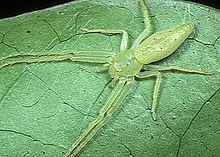Oxytate
| Grass crab spiders | |
|---|---|

| |
| A female green grass crab spider, O. argenteooculata, on a Cussonia leaf | |
| Scientific classification | |
| Domain: | Eukaryota |
| Kingdom: | Animalia |
| Phylum: | Arthropoda |
| Subphylum: | Chelicerata |
| Class: | Arachnida |
| Order: | Araneae |
| Infraorder: | Araneomorphae |
| Family: | Thomisidae |
| Genus: | Oxytate L. Koch, 1878[1] |
| Type species | |
| Oxytate striatipes | |
| Species | |
| Synonyms[1] | |
| |


The genus Oxytate, commonly known as grass crab spiders,[2] comprises a homogenous group of nocturnal crab spiders (family Thomisidae).[3] The complete mitochondrial genome of the type species O. striatipes was determined in 2014.[4]
Description
Although they do not construct webs, both sexes possess a silk apparatus. A study of the type species, O. striatipes, revealed that they possess a simpler and more primitive spigot system than other members of the family, as even the females possess neither tubuliform glands for cocoon production, nor triad spigots for web-building. Males and females do however have three types of silk gland, which are classified as ampullate, pyriform and aciniform.[5]
Four ampullate glands are connected to the anterior spinnerets, while eight minor ampullate glands are connected to the median spinnerets. The pyriform glands are connected to the anterior spinnerets (90 in females and 80 in males). The aciniform glands are connected to the median (18–24 in females and 14–20 in males) and posterior spinnerets (60 in either sex).[5]
Green crab spiders are very helpful to honeybee and plants to interact. Oxytate has an ability to reflect UV lights which makes flowers more attractive to honeybees. And by attracting honeybees, it is captured in a trap of crab spiders.[6]
Habits
Like other crab spiders, they are masters of ambush and disguise.[2] They stalk their prey at night, from an ambush position on a grass stem or from the underside of a leaf and are difficult to spot due to their camouflage. They can sense the vibrations caused by invertebrates moving on the leaf's upper side, and quickly pounce on the victim.[7] While in ambush on twigs or grass, the short hind legs hold onto the stem, while the long anterior legs are stretched forward.[2] Their bite is not harmful to humans, unless it would cause an allergic reaction.[8]
Range
They are native to Asia, Western Australia, East, Central and southern Africa.[9]
Species
As of October 2024, the World Spider Catalog accepted 30 species:[1]
- Oxytate argenteooculata (Simon, 1886) — Central, East, Southern Africa
- Oxytate attenuata (Thorell, 1895) — Myanmar
- Oxytate bhutanica Ono, 2001 — Bhutan, China
- Oxytate bicornis K. Liu, J. Liu & Xu, 2017 – China
- Oxytate capitulata Tang & Li, 2009 — China
- Oxytate chlorion (Simon, 1906) — India
- Oxytate clavulata Tang, Yin & Peng, 2008 — China
- Oxytate concolor (Caporiacco, 1947) — Ethiopia, Lesotho, South Africa
- Oxytate elongata (Tikader, 1980) — India
- Oxytate forcipata Zhang & Yin, 1998 — China
- Oxytate greenae (Tikader, 1980) — Andaman Islands
- Oxytate guangxiensis He & Hu, 1999 — China
- Oxytate hoshizuna Ono, 1978 — China, Japan
- Oxytate isolata (Hogg, 1914) — Western Australia
- Oxytate jannonei (Caporiacco, 1940) — Ethiopia
- Oxytate kanishkai (Gajbe, 2008) — India
- Oxytate leruthi (Lessert, 1943) — Ivory Coast, Ghana, the Democratic Republic of the Congo, Malawi, South Africa
- Oxytate lobia (Lee, Yoo & Kim, 2021) — Korea
- Oxytate mucunica (Liu, 2022) — China
- Oxytate multa Tang & Li, 2010 — China
- Oxytate palmata (K. Liu, J. Liu & Xu, 2017) — China
- Oxytate parallela (Simon, 1880) — China, Korea
- Oxytate phaenopomatiformis (Strand, 1907) — Zanzibar
- Oxytate placentiformis Wang, Chen & Zhang, 2012 — China
- Oxytate ribes (Jezequel, 1964) — Ivory Coast, South Africa
- Oxytate sangangensis Tang et al., 1999 — China
- Oxytate striatipes L. Koch, 1878 — Russia, China, Korea, Taiwan, Japan
- Oxytate subvirens (Strand, 1907) — Sri Lanka
- Oxytate taprobane Benjamin, 2001 — Sri Lanka
- Oxytate virens (Thorell, 1891) — Vietnam, Singapore, Thailand, Malaysia
See also
- Runcinia, also known as grass crab spiders
References
- ^ a b c d "Gen. Oxytate L. Koch, 1878". World Spider Catalog. Natural History Museum Bern. Retrieved 2024-10-20.
- ^ a b c Larsen, Norman. "Family: Thomisidae (crab spiders)". Biodiversity Explorer. Iziko Museums. Retrieved 31 July 2015.
- ^ Benjamin, Suresh P. (May 2001). "The genus Oxytate L. Koch 1878 from Sri Lanka, with description of Oxytate taprobane sp. n. (Araneae: Thomisidae)" (PDF). J. South Asian Nat. Hist. 5 (2): 153–158. Retrieved 31 July 2015.
- ^ Kim, Ji Young; Yoo, Jung Sun; Park, Yung Chul (16 October 2014). "The complete mitochondrial genome of the green crab spider (Araneae: Thomisidae)". Mitochondrial DNA. 27 (3): 1878–9. doi:10.3109/19401736.2014.971268. PMID 25319303. S2CID 3306196.
- ^ a b Moon, Myung-Jin; An, Jeong-Su (September 2006). "Microstructure of the silk spigots of the green crab spider Oxytate striatipes (Araneae: Thomisidae)". Entomological Research. 36 (3): 133–138. doi:10.1111/j.1748-5967.2006.00023.x. S2CID 85674275.
- ^ Heiling, A. M., Cheng, K., & Herberstein, M. E. (2004). Exploitation of floral signals by crab spiders (Thomisus spectabilis, Thomisidae). Behavioral Ecology, 15(2), 321–326. https://doi.org/10.1093/beheco/arh012.
- ^ Ono, H. (1978). "Thomisidae aus Japan II. Das Genus Oxytate L. Koch 1878 (Arachnida: Araneae)". Senckenbergiana Biol. (58): 245–521.
- ^ "Grass crab spider". pest-control.com. 2011. Retrieved 3 August 2015.
- ^ Ono, H. (1988). "A revisional study of the spider family Thomisidae (Arachnida, Araneae) of Japan". National Science Museum, Tokyo: 1–247.
